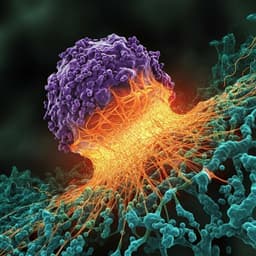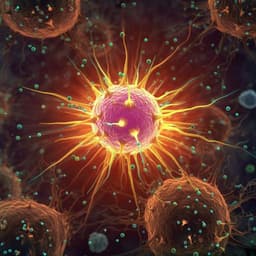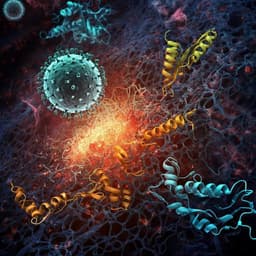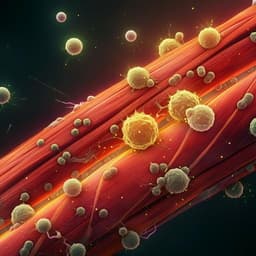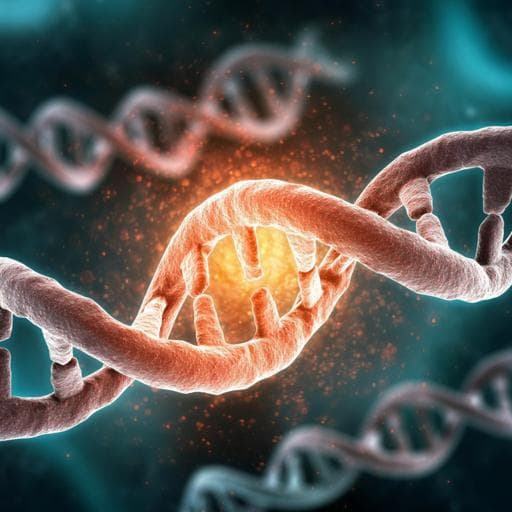
Medicine and Health
ROS induces NETosis by oxidizing DNA and initiating DNA repair
D. Azzouz, M. A. Khan, et al.
This exciting research conducted by Dhia Azzouz, Meraj A. Khan, and Nades Palaniyar unveils how reactive oxygen species (ROS) play a pivotal role in neutrophil extracellular trap (NET) formation. The study highlights the link between ROS-induced DNA damage and NETosis, demonstrating the importance of the DNA repair process in this intriguing mechanism.
~3 min • Beginner • English
Introduction
NETosis is a distinct form of programmed cell death in neutrophils triggered by agents such as PMA, bacterial LPS, Staphylococcus aureus (RN4220), or Pseudomonas aeruginosa. These agonists activate NADPH oxidase (NOX) to generate reactive oxygen species (ROS) and activate MAPKs (ERK, p38, JNK). Prior work showed genome-wide transcriptional firing, requiring transcription initiation but not translation, is necessary to decondense chromatin and drive NETosis. The role of DNA repair in NETosis, however, was unclear. Because NOX-dependent NETosis induces massive ROS, and ROS inhibition blocks NOX-dependent NETosis, the authors hypothesized that ROS induces DNA damage and that repairing this extensive damage opens chromatin and drives NETosis. ROS can oxidize DNA bases (e.g., conversion of guanine to 8-oxoguanine). Stalling of transcription at damaged sites recruits DNA repair machinery and opens chromatin for repair. Multiple base excision repair (BER) and nucleotide excision repair (NER) factors (e.g., OGG1, PCNA, APE1, PARP, DNA ligase, and DNA polymerases β/δ) participate in restoring DNA integrity. The study tests whether ROS-mediated DNA damage and specific steps of DNA repair are required to drive chromatin decondensation and NET formation.
Literature Review
The background establishes that NOX-derived ROS and MAPK signaling are essential for NOX-dependent NETosis, and that transcription initiation drives chromatin decondensation in NETosis. Pharmacologic or genetic inhibition of NOX abolishes NOX-dependent NETosis. ROS damages DNA, predominantly producing 8-oxoguanine, and cells repair such lesions mainly via BER or NER. In BER, lesion recognition/removal, APE1 incision, PARP activation with PARylation, and DNA ligase-mediated nick sealing are key steps; PCNA acts as a clamp to recruit repair polymerases β/δ, especially in long-patch BER or NER contexts. Prior reports indicated neutrophils store PCNA in the cytoplasm (proposed to regulate apoptosis) and carry other repair proteins (OGG1, PARP, pol β), though their functional significance in terminally differentiated neutrophils has been debated. The study builds on these insights to examine whether DNA repair contributes mechanistically to NETosis beyond canonical genome maintenance.
Methodology
Ethics: Human studies were approved by The Hospital for Sick Children ethics committee; informed consent obtained.
Neutrophil isolation: Peripheral blood from healthy donors collected in K2 EDTA tubes. Neutrophils isolated using PolymorphPrep with modifications, including hypotonic RBC lysis (0.2% NaCl), restoration with 1.6% NaCl + 20 mM HEPES (pH 7.2), washes in 0.85% NaCl + 10 mM HEPES (pH 7.2), and resuspension in RPMI + 10 mM HEPES (pH 7.2).
NETosis induction: NOX-dependent agonists PMA (typically 25 nM) or LPS (5 µg/ml), or bacteria S. aureus RN4220 and P. aeruginosa (20 MOI) were used. For HL-60-derived neutrophils, longer incubations (6–8 h) and PMA 150 nM or LPS 15 µg/ml were used.
SYTOX Green plate reader assay: Cells (5×10^5/ml) incubated with SYTOX Green (5 µM). Where indicated, preincubated 1 h with DNA repair pathway inhibitors dissolved in DMSO: APE1 inhibitors CRT0044876 (125 µM) and APE1 Inhibitor III (50 µM); PARP inhibitors BS1201 (100 µM) and PJ34 (50 µM); DNA ligase inhibitor L189 (100 µM); DNA polymerase β inhibitor AM-TS23 (25 µM); PCNA:pol δ interaction inhibitor T2AA (25 µM); polymerase δ inhibitor Aphidicolin (50 µM). After agonist addition, fluorescence (Ex 485/Em 525 nm) measured every 30 min for up to 240 min (neutrophils) or 6–8 h (HL-60-derived neutrophils). NETosis index normalized to 1% Triton X-100.
Confocal imaging: Cells (1×10^6/ml) treated ± inhibitors, fixed with 4% PFA, permeabilized with 1% Triton X-100 (25 min), blocked with 2.5% BSA (1 h). Primary antibodies: mouse anti-PCNA (F-2, 1:250), mouse anti-8-oxoG (MAB3560, 1:250). DNA stained with DAPI (10 µM; 1:333). NET validation included MPO staining (MPO, green). Imaging on Olympus IX81 with Hamamatsu C9100-13 EM-CCD and Yokogawa CSU x1 spinning disk.
In-cell ELISA for 8-oxoG: Cells (5×10^6/ml) treated with PMA or LPS for 2 h, fixed, permeabilized, blocked as above; probed with anti-8-oxoG (1:250). Fluorescence measured on POLARstar OMEGA.
siRNA knockdown (HL-60): HL-60 cells cultured in DMEM + 10% FBS; differentiated with 7% dimethylformamide (medium refreshed after 2 days). On day 4, transfected (HiPerfect) with 25 nM siRNA (scrambled, APE1, or PARP1; Qiagen). After 24 h, cells washed and used for NETosis assays with PMA or LPS (6–8 h). Knockdown confirmed by Western blot (anti-APE1 ab194, anti-PARP #9542, anti-GAPDH ab9483; HRP detection).
Statistics: GraphPad Prism 7. One-way or two-way ANOVA with appropriate post-tests, and Student’s t-test. Variances similar; data as mean ± SEM; significance p<0.05.
Key Findings
- ROS induces extensive oxidative DNA damage during NOX-dependent NETosis:
• Immunofluorescence showed abundant 8-oxoguanine (8-oxoG) throughout NET DNA after PMA (25 nM) or LPS (5 µg/ml) treatment for 240 min.
• In-cell ELISA quantified significantly increased 8-oxoG in PMA- or LPS-treated neutrophils versus media controls (n=6; p<0.05).
- PCNA, a key DNA repair factor stored in the cytoplasm of resting neutrophils, translocates to the nucleus during early NETosis and decorates NET DNA later:
• After PMA (60–120 min) or LPS (30–60 min), PCNA localized to nuclear/perinuclear regions; by 4 h, PCNA was distributed across NET structures and colocalized with NET markers (e.g., MPO).
- Early steps of DNA repair are required for NETosis, whereas later steps are dispensable under strong NOX-dependent stimulation:
• Pharmacologic inhibition of APE1 (CRT0044876; APE1 Inhibitor III), PARP1 (BS1201; PJ34), or DNA ligase (L189) significantly decreased PMA-induced NETosis in primary neutrophils (SYTOX assay; n=3; p<0.05), corroborated by microscopy.
• In contrast, inhibition of PCNA:polymerase interactions (T2AA), polymerase δ (Aphidicolin), or polymerase β (AM-TS23) did not reduce PMA-induced NETosis (inhibitors validated in separate assays).
- Genetic knockdown supports inhibitor data:
• siRNA-mediated knockdown of APE1 or PARP1 in differentiated HL-60 neutrophils reduced NETosis induced by PMA (150 nM) or LPS (15 µg/ml) over 6–8 h, with knockdown verified by Western blot (n=4; p<0.05).
- Findings extend to biologically relevant stimuli:
• The same early-repair inhibitors (APE1, PARP1, DNA ligase) significantly suppressed NETosis induced by S. aureus RN4220 and P. aeruginosa (20 MOI) in primary neutrophils (SYTOX assay; n=3; p<0.05), with imaging confirming reduced NET release.
Overall, ROS-driven DNA damage (notably 8-oxoG formation) triggers recruitment of DNA repair machinery; assembly and incision/nicking steps up to DNA ligase drive chromatin decondensation necessary for NETosis, whereas downstream synthesis steps involving PCNA:polymerase interactions are not required under these conditions.
Discussion
The study addresses how ROS mechanistically induces NETosis by demonstrating that ROS causes extensive oxidative DNA damage, which in turn recruits DNA repair machinery that drives chromatin decondensation. PCNA translocation from cytoplasm to nucleus and subsequent association with NET DNA indicates active engagement of repair processes during NETosis. Pharmacologic and genetic perturbations show that early steps of BER/NER—particularly APE1 incision, PARP activation/PARylation, and DNA ligase-associated nick formation—are necessary for NET release, while later synthesis steps mediated by PCNA and repair polymerases are dispensable in strong NOX-dependent contexts. This suggests that chromatin opening and nicking, rather than completion of repair synthesis, are the critical functions enabling chromatin decondensation leading to NETosis. The findings integrate with prior evidence that MAPK-driven transcription initiation promotes chromatin decondensation: ROS-induced DNA lesions stall RNA polymerase, coupling transcriptional firing to recruitment of repair complexes, thereby synergizing two chromatin-unwinding machineries. The data support a model in which short-patch BER predominates in terminally differentiated neutrophils and suffices to promote chromatin relaxation necessary for NETosis, without requiring DNA replication. The work assigns a noncanonical role to DNA repair components in neutrophils—facilitating a do-or-die response culminating in NET formation—and highlights early BER steps as potential therapeutic targets in NETosis-driven diseases.
Conclusion
Excess ROS generated during NOX-dependent NETosis oxidizes DNA bases (notably forming 8-oxoG), leading to widespread DNA damage. Neutrophils respond by mobilizing DNA repair factors such as PCNA into the nucleus; assembly of early BER/NER components (APE1, PARP, DNA ligase) and consequent nick formation drive chromatin decondensation that is essential for NET release. Inhibiting these early steps suppresses NETosis induced by PMA, LPS, S. aureus, and P. aeruginosa, whereas inhibiting later steps involving PCNA–polymerase interactions does not. These findings elucidate a key mechanism linking ROS to NETosis and suggest that selective targeting of early DNA repair steps may modulate pathological NET formation in conditions such as lupus, autoimmune diseases, and sepsis. Future work should define the precise contributions of BER versus NER, assess roles of PCNA and polymerases in other NETosis forms, and explore therapeutic modulation in vivo.
Limitations
- Primary neutrophils are not amenable to siRNA knockdown; genetic validation was performed in differentiated HL-60 cells, which may not fully recapitulate primary neutrophil biology.
- The base-removal (glycosylase) step was not directly targeted because different glycosylases handle distinct lesions; thus, contributions of specific glycosylases (e.g., OGG1) were not dissected.
- While inhibitors for later steps (PCNA:polymerase interactions and polymerase activities) did not suppress NETosis under strong NOX-dependent stimulation, the study cannot exclude roles for these proteins in other contexts, stages, or forms of NETosis.
- Quantitative distribution of DNA damage and repair across the genome was inferred from imaging and ELISA rather than high-resolution mapping.
- Pharmacological inhibitors may have off-target effects; although multiple inhibitors per target and complementary genetic knockdown were used, complete specificity cannot be guaranteed.
Related Publications
Explore these studies to deepen your understanding of the subject.



